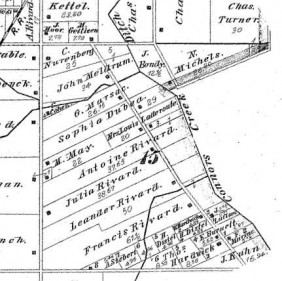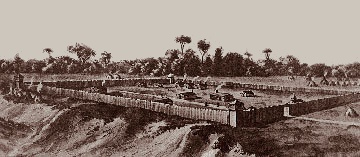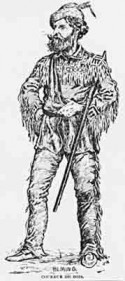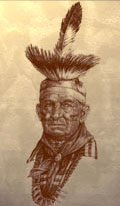
Angled lots along the Detroit river in the old French city. Map courtesy Michigan Historical Society.
I swear, if I have to drive Up North in one shot again I will slit my wrists. I am getting too old for that, but don’t have enough time to make it a relaxed two-day trip with a stay in a dump motel in Elyria, Ohio in the middle.
That is one reason why I was so excited to hear that they had re-scheduled the big annual IT conference in Detroit. That way I will be able to fly two thirds of the way from Washington, and then only have to drive five hundred miles instead of the usual 1700 to look in on the folks Up North and see how they are getting along.
A lot of the prospective attendees at the Conference are not as excited as I am. They have taken the news of the 25% decline in the population of the city over the last decade as some sort of barometer of decay. Maybe it is the reports of vast swaths of prairie that are springing up where there used to be neighborhoods, or the crime, or the generally dismal economic situation in the state.
I think Detroit is a great town, and while it has some challenges, it has always been a key venue for the great migrations on the North American continent.
In fact, the Motor City goes back to ground zero for the European expansion west. Back in the 1600’s, France began establishing forts at strategic locations along the waterways that connect the largest accumulation of fresh water on the planet. The goal was to keep the Brits contained in New England, and establish a trade monopoly with the local indigenous peoples.
One of the boldest of the French, a man named Antoine de la Mothe Cadillac, felt that the narrows known as “le detroit,” or the straits between Lake Erie and Saint Claire, was an obvious location for a major fortification. The King agreed, and a stockade on the Detroit River was erected in 1701.

Steel engraving conceiving Fort Ponchartrain. Courtesy Gross Point Historical Society.
Cadillac’s Fort Ponchartrain was not the first settlement in the area, since in addition to the black-robed Jesuits had passed through attempting to save souls, and the woods-runners- the coureurs de bois- had interacted and sometimes intermarried with the resident Great Lakes Ottawa as early as 1615, when the English were just clinging to life at Jamestown in sultry Virginia.

French "runner of the woods"
Members of the Algonquin language family, the Ottawa, along with the Chippewa and Potowatomi were known to other Algonquins as intertribal traders who marketed corn meal, furs, skins, tobacco and foodstuffs to the other bands. The name Ottawa in the Algonquin language means “to trade.”

Ottowa Man. Etching from The History of Native American Tribes.
And that is what Detroit was always about, from the earliest days. You can still sense the old French presence in town from the orientation of the streets along the river, and their names. They did not hew to the great English grid system of organization; rather, the lots were narrow and followed the course of the river. The street names evoke the ethnicity of the early migrants: Chene, Beaufait, Livernois, Beaubien, Cadieux, St. Aubin, Lambert and of course, fabulous Livernois.
I will touch on the waves of migrants who came after as we get to it, since the history of who came to Detroit is also the story of who left it, but I got more bad news yesterday about my birth city, which may affect the convention.
I have a pal there who keeps me up to date on what is going on. Of course, he doesn’t live in the city- he is in Ann Arbor, well enough away to the west to be out of the immediate frag pattern. He wrote me yesterday to say this:
“Newly-elected Governor Snyder has severely reduced the number of State Police posts in Detroit. Please tell your colleagues who plan on attending the conference that they could be “on their own” in small-government Tea-Party-America.
They will need to carry handguns with them at all times. They will have to provide for their own protection. And tell them to shoot to kill, we may not have enough money to “house prisoners” anymore. Oh, wait prisons will be outsourced to some jerk who got a tax cut.”
I assume he was at least speaking in jest. In my experience, blighted areas are the places where gun laws are the strictest, just like they are in Washington, DC. Still, I recall what Roger the Dodger used to say at the house on John Street back in college. His Dad was a Detroit cop, back when it was largely an all-white force, though the city itself was already in transition to something else.
“You can’t shoot people outdoors,” he said. “So make sure you drag them inside before the police come. Or at least get a belt or a shoe.”
More on the great migrations tomorrow.
Copyright 2011 Vic Socotra
www.vicsocotra.com
